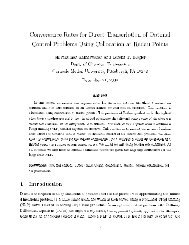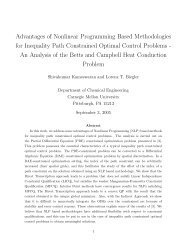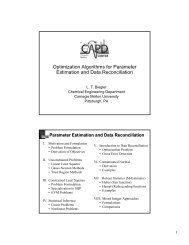RegEq(ǫ): m<strong>in</strong> f(w) (19a)s.t. h(w) = 0 (19b)g(w) ≥ 0(19c)x, y ≥ 0 (19d)x i y i = ǫ ∀i (19e)PF(ρ): m<strong>in</strong> f(w) + ρx T y (20a)s.t. h(w) = 0 (20b)g(w) ≥ 0(20c)x, y ≥ 0 (20d)Complementarity conditions may be relaxed and the problem reformulated as<strong>in</strong> the Reg(ǫ), RegComp(ǫ), or RegEq(ǫ) with a positive relaxation parameterǫ. The solution of the MPCC, w ∗ , can be obta<strong>in</strong>ed by solv<strong>in</strong>g a series of relaxedsolutions, w(ǫ), as ǫ approaches zero. These solution strategies are generally attractedto strongly stationary po<strong>in</strong>ts, but with some exceptions (see [1]). Underassumptions of <strong>MPEC</strong>-MFCQ and sufficient second order <strong>MPEC</strong> conditions [24],Reg(ǫ) and RegComp(ǫ) exhibit local convergence of ‖w(ǫ) − w ∗ ‖ ≤ O ( ǫ 1/2) .(These properties can be strengthened to O (ǫ) if we can assume strict complementarityof the bound multipliers for i ∈ I X ∪ I Y .) Reg(ǫ) has been implementedand tested <strong>in</strong> a version of IPOPT called IPOPT-C [22]. On the otherhand, RegEq(ǫ) will exhibit slower convergence with ‖w(ǫ) − w ∗ ‖ ≤ O ( ǫ 1/4)under the same assumptions.In a related development, Nonl<strong>in</strong>ear Complementarity <strong>Problem</strong> (NCP) functionsand smooth<strong>in</strong>g functions have also been used extensively to solve MPCCs[3, 10, 14, 28]. NCP functions replace the complementarity condition <strong>in</strong> theproblem with an equivalent nonl<strong>in</strong>ear equation. One widely studied NCP functionis the Fischer-Burmeister function:φ(x, y) = x + y − √ x 2 + y 2 (21)As this function is non-differentiable at x = y = 0, it is usually smoothed to theform:φ(x, y) = x + y − √ x 2 + y 2 + ǫ (22)for some small ǫ > 0. The solution to the orig<strong>in</strong>al problem is then recovered bysolv<strong>in</strong>g a series of problems as ǫ approaches zero. An equivalence can be madebetween this method and RegEq(ǫ). Accord<strong>in</strong>gly, the problem will converge atthe same slow convergence rate.In contrast to the regularized formulations, we also consider the exact l 1penalization shown <strong>in</strong> PF(ρ). Here the complementarity can be moved fromthe constra<strong>in</strong>ts to the objective function and the result<strong>in</strong>g problem is solvedfor a particular value of ρ. If ρ ≥ ρ c , where ρ c is the critical value of thepenalty parameter, then the complementarity constra<strong>in</strong>ts will be satisfied at8
the solution. Similarly, Anitescu et al. [1] consider a related “elastic mode”formulation, where artificial variables are <strong>in</strong>troduced to relax the constra<strong>in</strong>ts <strong>in</strong>PF(ρ) and an additional l ∞ constra<strong>in</strong>t penalty term is added. In both cases theresult<strong>in</strong>g NLP formulation has the follow<strong>in</strong>g properties:Theorem 2 [1] If w ∗ is a solution to PF(ρ) and w ∗ is feasible for the MPCC(3), then w ∗ is a strongly stationary solution to (3).However, the value of ρ c is not known beforehand. If the <strong>in</strong>itial value is toosmall a series of problems with <strong>in</strong>creas<strong>in</strong>g ρ values may need to be solved, andhere we can apply the follow<strong>in</strong>g result:Theorem 3 [15] If w ∗ is a limit po<strong>in</strong>t of a sequence of solutions {w k } toPF(ρ k ), <strong>MPEC</strong>-LICQ holds and ρ k x k i → 0 and ρ k yi k → 0 for i ∈ I X ∪ I Y ,then w ∗ is a strongly stationary solution to (3).Hence, the solution strategy is attracted to strongly stationary po<strong>in</strong>ts, andwith a large enough ρ this l 1 penalization is exact <strong>in</strong> the sense that all stronglystationary po<strong>in</strong>ts of the MPCC are local m<strong>in</strong>imizers to PF(ρ). PF(ρ) allowsany general nonl<strong>in</strong>ear programm<strong>in</strong>g solver to be used to solve a complementarityproblem. Provided that the penalty parameter is large enough, the MPCCmay then be solved as a s<strong>in</strong>gle problem, <strong>in</strong>stead of a series of problems. F<strong>in</strong>ally,<strong>in</strong> order to provide greater numerical efficiency, it has been suggested todynamically change the penalty parameter dur<strong>in</strong>g the course of the optimizationfor both active set and <strong>in</strong>terior po<strong>in</strong>t optimization algorithms [1, 15]. Thismodification was recently <strong>in</strong>troduced <strong>in</strong>to the solver KNITRO [16].F<strong>in</strong>ally, there is a strong <strong>in</strong>teraction between the MPCC reformulation andthe applied NLP solver. In particular, as noted <strong>in</strong> [15], if a barrier NLP method(like KNITRO or IPOPT) is applied to PF(ρ), then there is a one-to-one correspondenceof <strong>in</strong>termediate solutions of PF(ρ), Reg(ǫ) and RegComp(ǫ). Thisequivalence can be seen by compar<strong>in</strong>g the penalty parameter ρ to the multiplierassociated with the relaxed complementarity constra<strong>in</strong>ts <strong>in</strong> Reg(ǫ) andRegComp(ǫ). As a result, for a correspond<strong>in</strong>g set of parameters ρ and ǫ wewould expect a barrier NLP method to exhibit similar performance with eitherPF(ρ), Reg(ǫ) or RegComp(ǫ).4 <strong>MPEC</strong>Lib ResultsThe formulations of the previous section provide a straightforward way to representand address any MPCC through nonl<strong>in</strong>ear programm<strong>in</strong>g. An importantcomponent of this task is the efficient and reliability of the NLP solver. In thissection we compare and evaluate each of these formulations through a librarytest set provided with the GAMS model<strong>in</strong>g environment [8]. For this evaluationwe consider <strong>MPEC</strong>Lib, a large collection of test problems, and apply an automaticreformulation of <strong>MPEC</strong>s provided by the NLPEC meta-solver <strong>in</strong> GAMS.9






